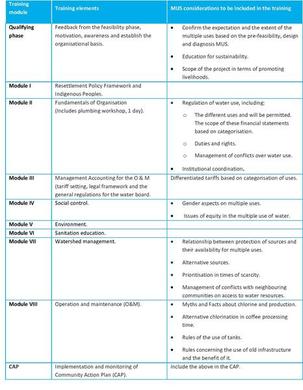Tool 21
TOOL 21. TRAINING OF (COMMUNITY LEVEL) SERVICE PROVIDERS
To train service providers on their roles and responsibilities. Whereas it is realised that training of service providers covers a wide spectrum of issue, here we only focus on the role and responsibilities with specific reference to multiple-use water services.
OBJECTIVE
To train service providers on their roles and responsibilities. Whereas it is realised that training of service providers covers a wide spectrum of issue, here we only focus on the role and responsibilities with specific reference to multiple-use water services.
METHOD
The training of the service provider is led by a facilitator who exposes certain issues, after which the group discusses or carries out exercises related to the issues. Below is a list of issues to be discussed:
- Control of use of water from water points for different purposes. The water service provider needs to know which uses of water from a water point are permitted, and which ones not. For example, can water be taken from a pump for a private garden or not. Often this is locally specific.
- Priority setting in case of breakdown or shortage. Even though certain uses may be foreseen in planning, it can be that water is not always available. For example, a borehole may provide a community garden. But sometimes, the water table drops too far and only enough water is available for domestic uses. The water service provider needs then to regulate how the limited amount of water is being used.
- Linkages with other institutions. For many livelihood activities, it may be necessary to draw support from other institutions. The water service provider can play a key role in linking with such institutions. It is important for the water service provider to know its role in this.
- In cases where standard curricula exist for training of service providers, focussed on single-use water services, it is advisable to add additional modules or to adapt certain modules to include MUS specific aspects, rather than designing a completely separate training programme. An example of this can be found in Table 15.
Table 15 - Adaption to water board training in Honduras to take into account MUS issues

Source: Smits and Mejía, 2011
BASED ON
Tool 19 in: ZIMWASH, 2010. Guidelines for Planning for Water for Livelihoods, Harare: ZIMWASH Project.
Tool 13 in: Smits, S. and Mejía, T., 2011. Guía para la Planificación e Implementación de Proyectos de Usos Múltiples del Agua, The Hague / Tegucigalpa: IRC/ RASHON.
